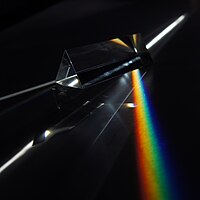
Photo from wikipedia
Abstract The formation of heterostructure nanocomposite has been demonstrated to be an effective route to enhance the photocatalytic efficiency. Ternary chalcogenides (TC) with remarkable visible light absorption, are identified as… Click to show full abstract
Abstract The formation of heterostructure nanocomposite has been demonstrated to be an effective route to enhance the photocatalytic efficiency. Ternary chalcogenides (TC) with remarkable visible light absorption, are identified as an ideal candidate to form heterostructure with classical semiconductors such as TiO2. In the current investigation, novel heterojunctions of the AgBiS2-TiO2 composite were synthesised using a solvothermal technique. Computational analysis was utilised to study the electronic and optical properties of the pristine parent samples. The XRD results show the formation of the cubic phase of AgBiS2 and TiO2 is in tetragonal phase. The XPS and the TEM results illustrate the heterostructure formation. The UV-DRS pattern for all the composites shows enhanced visible light absorption due to the coupling of TC. The band gaps of the composites were decreased with increased doping levels. These materials were further studied for their photocatalytic efficiency, by photocatalytic degradation of Doxycycline, photocatalytic hydrogen generation and photocatalytic antimicrobial disinfection. The composite samples illustrated more than 95% degradation results within 180 min and showed about 3 log reductions of bacterial strains (E. coli and S. aureus) within 30 min of irradiation. The hydrogen production results were interesting as the AgBiS2 based composites illustrated a 1000-fold enhanced output. The enhanced photocatalytic activity is attributed to the decreased rate of recombination of the photogenerated excitons, as validated in the PL measurements. The scavenging experiments along with the theoretical analysis are used to define a plausible photocatalytic mechanism.
Journal Title: Applied Catalysis B: Environmental
Year Published: 2019
Link to full text (if available)
Share on Social Media: Sign Up to like & get
recommendations!